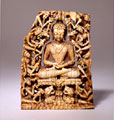 |
|
 |
 |
 |
 |
 |
 |
 |
 |
Sculpture from Kashmir
Kashmir's apparent seclusion in a valley in the northwest of India belies its importance as a crossroads linking northern India with parts of Central Asia, China, and Tibet. Consequently, there is a range of stylistic influences in Kashmiri art, which has, in turn, had a significant impact on the art of other places such as western Tibet. Architecture, painting, and sculpture flourished in Kashmir during the 8th and 9th centuries, reflecting the power and influence of the kingdom at this time. The development of the arts during this period is attributed to the patronage of King Lalitaditya (reigned ca. 724-750), who expanded Kashmir's borders and acquired the great wealth needed to support the large-scale production of art, and to his less well-known predecessors and successors who also had long and prosperous reigns. Hinduism and Buddhism appear to have coexisted peacefully in Kashmir until about the 11th century, as evidenced by texts which describe kings such as Lalitaditya's simultaneous patronage of both Hindu and Buddhist structures. Islamicization began in the 14th century in Kashmir, and today its population is predominantly Muslim. |
 |
 |
| 1 thru 4 of 4 |
 |
| view text only list |
 |

Buddha Shakyamuni |
 |

Vishnu |
 |

Crowned Buddha Shakyamuni |
 |

Bodhisattva Avalokiteshvara |
 |
|
 |